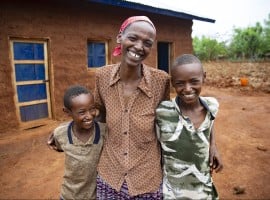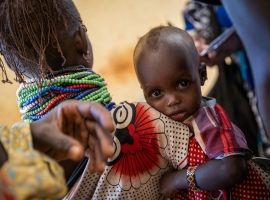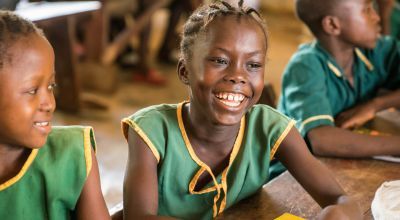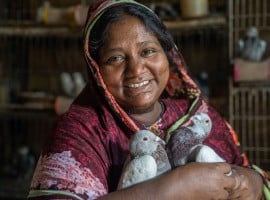
Read our 2024 annual report

Knowledge Hub
In recent years, we’ve noticed an increasing number of articles and discussions about the “least-educated” countries or countries with the “worst” education. But those phrases don’t tell the whole story.
The problems facing education today are far from simple, and they have very real effects on hundreds of millions of children around the world. That includes the 251 million children who won’t be returning to the classroom this autumn.
To get a true sense of a complex issue, we’ve turned to the United Nations’ 2025 Human Development Index. This annual report includes data on the average expected years of schooling in each country with the mean years of schooling. These figures are adjusted to account for inequalities along gender, income, and geographic lines to get a truer understanding of education in each country. With those in mind, these are the 15 countries where it is toughest to get an education.
15. Sudan
The conflict in Sudan — and resulting humanitarian crisis — have had an impact on education in the country. Even before then, however, children were struggling to get an education. With an expected 8.6 years of education per child, students on average only get four years of school.
Things have got worse since April 2023: An estimated 19 million children are out of school, and over 90% of the country’s schools have either been closed, destroyed, or made inaccessible. In October 2023, UNICEF’s Mandeep O’Brien warned: “Sudan is on the brink of becoming home to the worst education crisis in the world.”
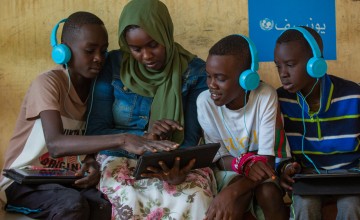
14. South Sudan
With high rates of malnutrition, displacement, and violence, South Sudan is one of the worst countries to be a child. While most children receive their full education, the expectation is low, with 5.6 years established for education.
In discussing education in South Sudan, the United Nations Educational, Scientific and Cultural Organisation (UNESCO) also points to a figure called “learning-adjusted years of schooling.” This is an average of the years of education a child is expected to accomplish against their test scores — leading to a sense of “true” education. UNESCO estimates that South Sudanese students only receive 2.5 years of “true” education, in part due to qualified teacher shortages in the country.
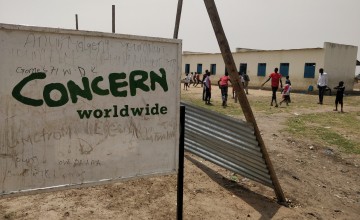
13. Yemen
Recent figures from UNICEF show that school-aged children represent 33% of the Yemeni population. More than a decade of conflict has created what the UN calls an “education crisis” in the country, with 4.5 million children (one third of all children in Yemen) out of school as of 2023. Over 2,400 schools have either been damaged or closed due to ongoing conflict. There are also considerable gaps in completion rates between children in low-income and high-income communities, and between rural and urban students.
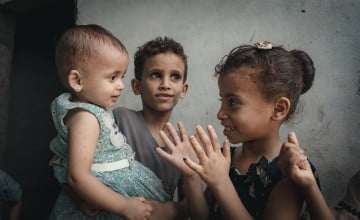
12. Pakistan
Roughly 26.2 million children in Pakistan are out of school — especially girls. According to UNESCO, the country faces a number of challenges including structural, governance, capacity, financing, and evaluation to deliver quality education to its students. Of the 7.9 years expected for education, the average student only completes 4.3 — and that number is significantly higher in rural areas. A recent challenge was the 2022 floods, which kept 3.5 million children out of the classroom in the immediate aftermath and destroyed hundreds of schools. As of last year, nearly a quarter of a million children were still facing barriers to education as a result of the disaster.

11. Afghanistan
UNESCO’s records for Afghanistan give us data from 2015 and 2022, which is a useful comparison given shifts within the country over those seven years. Unfortunately, many figures around enrolment and completion have gone down in that time. Primary education completion rates in 2022 were down over 10 percentage points compared to 2015.
Afghan girls and women face an especially uncertain future, with UNESCO suggesting that at least 1.4 million girls have been excluded from secondary education since 2021. (Since 2022, women have also been banned from universities.) However, educational attainment has gone down for both boys and girls: Of the 10.8 expected years of schooling, the average student only completed 2.5 in 2023.
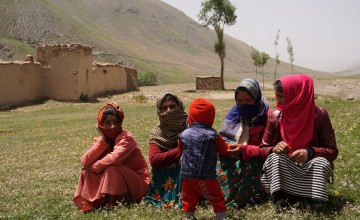
10. Sierra Leone
In some ways, Sierra Leone is still recovering from its brutal civil war (1991-2002) and the world’s largest Ebola outbreak (2014-16), especially when it comes to recovering lost education. The Sierra Leonean government has significantly increased its investment in education over the last decade. Before the Ebola outbreak, more than 15% of its federal budget was earmarked for education. Since coming out of the epidemic, it has invested between 29% and 35% of its annual budget in education in an effort to increase matriculation rates: Of the 9.1 expected years of schooling, the average student only completes 3.5.
Concern has worked with the Ministry of Education on the Safe Learning Model, a pioneering, multi-million euro, five-year programme funded by Irish Aid designed to address school-related gender-based violence. We also recently concluded a five-year project, Every Adolescent Girl Empowered and Resilient (EAGER), which worked with girls ages 13 to 19 who either never attended school or had dropped out in order to build literacy, numeracy, financial, and other life skills, along with small businesses.
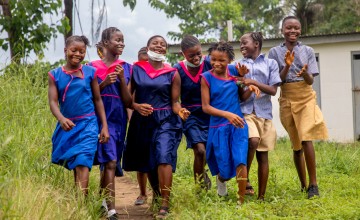
9. Ethiopia
World Bank data show a 25% drop in primary school enrollment between 2020 and 2022 in Ethiopia, correlating with both the pandemic and regional conflict. In fact, 2022’s enrollment rates were the lowest since 2006. In the 2023-24 school year, nearly 42% of school-aged children in the Amhara region were out of school (an estimated 2.6 million pupils), with over 3,700 schools shut down due to the fighting. The average student only completes 2.4 years of school, compared to an expected education of 9.2 years.
Concern has been responding to this particular crisis with our Play Matters initiative. Last year in Amhara, it helped 17,000 children attend school in a safe environment, improving enrolment and retention rates by 10%.
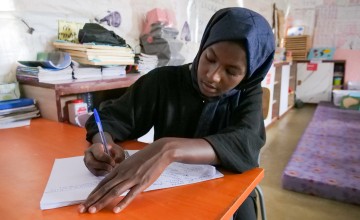
8. Senegal
In the latest HDI, the United Nations notes that the average educational attainment in Senegal is 2.9 years, compared to an expected 9.1 years of schooling. The World Bank also notes that Senegalese students score below global averages for standardised tests.
7. Guinea
Education for girls in Guinea is especially difficult, according to UNESCO. Primary school completion rates for the country were 56% for girls and 70% for boys in 2021. A similar gap existed in secondary school completion, with only 31% of girls enrolling compared to 41% of boys. Overall, with an estimated 10.4 years of education planned for each child, the average student will still only get 2.5 years.
6. Niger
Of the countries on this list, Niger has the lowest average for educational attainment: just 1.4 years (out of an expected 8.3). Five years of heightened insecurity in the Sahel (the area that includes Niger, as well as Chad, Burkina Faso, and Mali — all below) have nearly doubled the number of school closures, resulting in over 13,200 schools closed across eight countries in central and west Africa. This included approximately 940 schools in Niger as of early 2024, affecting over 74,000 students and nearly 1,800 teachers.
Education has been a priority for the Nigerien government and in recent years, before regional violence and political instability escalated, there had been several successes in enrolment and educational outcomes. Concern’s education programme in Niger includes the Learning Together initiative, which reached over 75,000 children across 250 schools. We rehabilitated more than 80 classrooms in 29 schools, and in areas where schools were closed due to regional insecurity, our distance learning project ensured that more than 2,000 students still kept up with school through audio lessons led by community facilitators.

5. Chad
Fewer than 34% of students in Chad are expected to complete primary school as of 2023. That rate is even lower in rural areas, where children are just 19% likely to complete primary school. Of the 8.3 expected years of schooling, the average student only completes 2.3.
Concern has worked in Chad for nearly two decades, including a focus on education. Last year, we supported 17 schools in the rural district of Goz Beida, raising attendance rates from 47% in 2023 to 65% in 2024 through community outreach campaigns. We offered free school enrolment and provided more than 2,600 children with school kits. We also supported the Provincial Education Delegation by recruiting and retaining 42 qualified teachers, and providing continuous teacher training for 97 participants. As a result, Early Grade Reading Assessment (EGRA) scores increased from 0% to 7%.
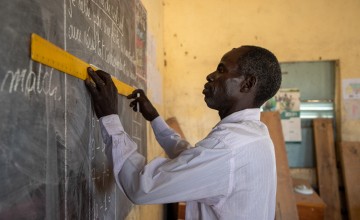
4. Burkina Faso
An ongoing crisis in Burkina Faso has contributed to an education loss for a country where 43% of the population is aged 14 or younger. A World Bank brief suggests that 74% of all Burkinabè in the final years of primary school are not proficient in reading, and that 67% have not achieved the minimum proficiency level in literacy. That’s to say nothing of the 21% of primary school-aged children who are not enrolled at all, in many cases due to security concerns and over 6,100 schools reported closed as of last year.
In recent years, we’ve seen some gains in education, with UNESCO reporting that the completion rate for upper-secondary education in rural areas of the country more than doubled between 2017 and 2021. However, overall completion rates for primary, lower-secondary, and upper-secondary education have all dropped in recent years and we continue to see a wide gap between educational opportunities in urban versus rural areas, and between families with higher and lower incomes.

3. Djibouti
Over the last decade, Djibouti has improved enrolment rate for primary education (from 55% in 2012 to 64% in 2022). However, while the overall completion rate for primary education was 81% in 2017, there were large discrepancies in this figure when region was brought into account; girls in rural areas of the country, for example, were only 42% likely to complete primary school.
2. Somalia
In Somalia, a cyclical crisis fuelled by conflict, climate disasters, and poverty has resulted in 4 million children being out of school. Those who are enrolled complete an average of 1.9 years of their education (just 25% of an expected 7.5 years), and schools are often overcrowded and under-resourced.
Concern’s commitment to education in Somalia reached over 36,000 students last year, including 30,000 in displacement-affected communities attending 26 schools across the Banadir, Lower Shabelle, and Bay regions. We have refurbished classrooms, built and fully equipped news schools, and set up temporary learning spaces (TLS). The TLS has provided a safe learning environment for almost 6,400 students in Mogadishu, and helped to increase enrolment in schools by 29% last year. We’ve also provided students with school supplies and textbooks, and schools with teaching and office materials — ensuring that teachers and administrators have the tools they need to deliver high-quality education.
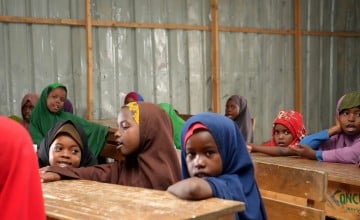
1. Mali
Since 2010, completion rates for primary school in Mali have increased from 38% to 56.5%, marking significant gains even as conflict began to affect the country (and the wider Sahel region) beginning in 2012. However, on average most children have still only completed 1.6 years of school compared to an expected 7 years of education.
The World Bank reports that 91% of children enrolled in primary school in the country are not proficient in reading, and 87% do not meet the minimum standard levels of proficiency. These numbers are adjusted for the children currently in school, but overlooks the 33% of school-aged children in Mali who are not enrolled at all.
Note: Some countries were not fully accounted for on the UN’s latest HDI, particularly with regards to the inequality-adjusted education index. These countries include Syria, where Concern has been actively working to restore education. Our Non-Formal Education Programme in Syria reached over 14,700 people in 2024.
Concern’s work in education
Concern’s work is grounded in the belief that all children have a right to a quality education. We integrate our education programmes into both our development and emergency work to give children living in extreme poverty more opportunities in life and supporting their overall wellbeing. Our focus is on improving access to education, improving the quality of teaching and learning, and fostering safe learning environments
We've brought quality education to villages that are off the grid, engaged local community leaders to find solutions to keep girls in school, and provided mentorship and training for teachers. Last year alone, we reached nearly 700,000 people with education programmes across nine countries.
